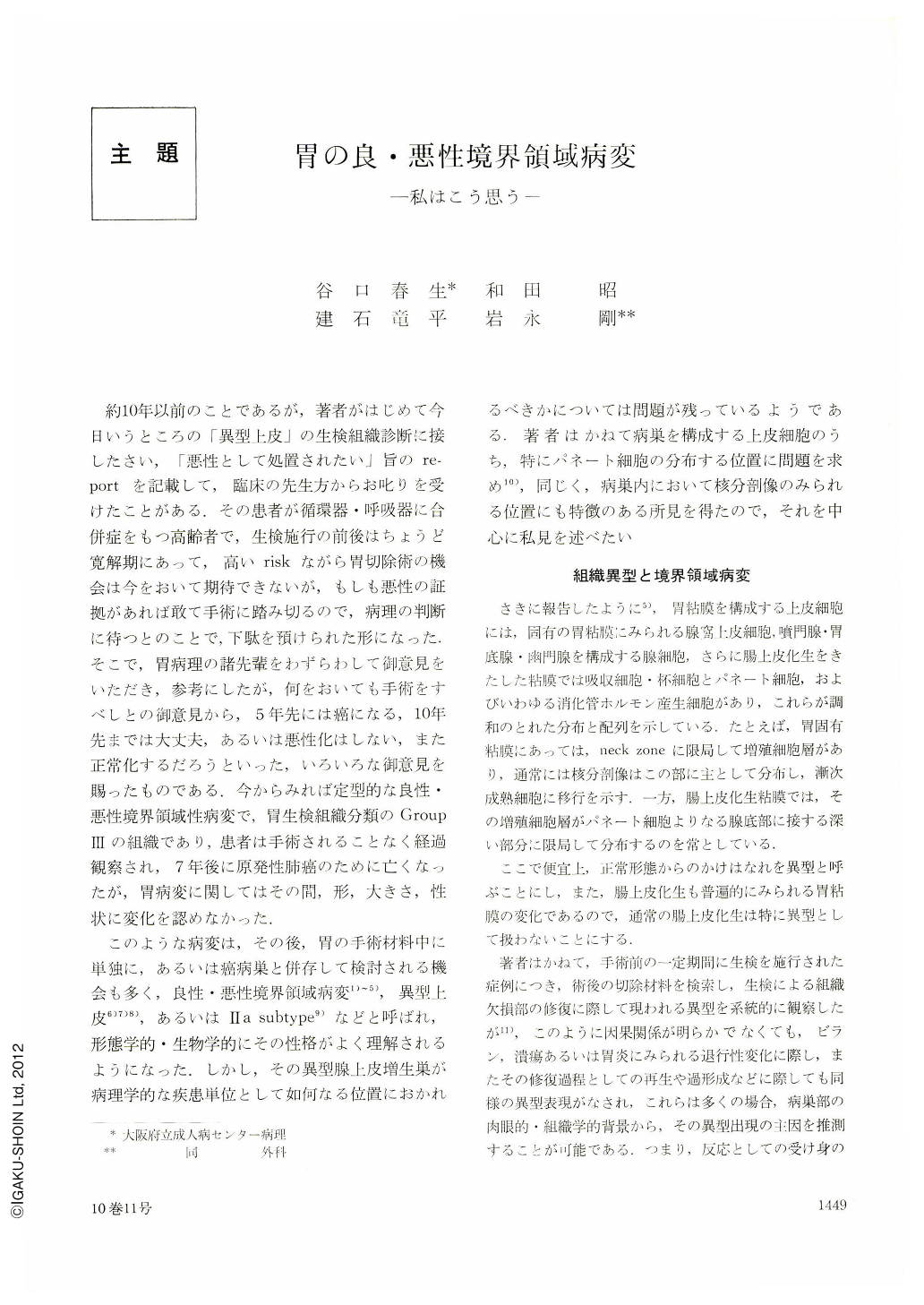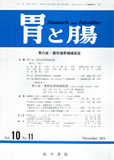Japanese
English
- 有料閲覧
- Abstract 文献概要
- 1ページ目 Look Inside
約10年以前のことであるが,著者がはじめて今日いうところの「異型上皮」の生検組織診断に接したさい,「悪性として処置されたい」旨のreportを記載して,臨床の先生方からお叱りを受けたことがある.その患者が循環器・呼吸器に合併症をもつ高齢者で,生検施行の前後はちょうど寛解期にあって,高いriskながら胃切除術の機会は今をおいて期待できないが,もしも悪性の証拠があれば敢て手術に踏み切るので,病理の判断に待つとのことで,下駄を預けられた形になった.そこで,胃病理の諸先輩をわずらわして御意見をいただき,参考にしたが,何をおいても手術をすべしとの御意見から,5年先には癌になる,10年先までは大丈夫,あるいは悪性化はしない,また正常化するだろうといった,いろいろな御意見を賜ったものである.今からみれば定型的な良性・悪性境界領域性病変で,胃生検組織分類のGroup Ⅲの組織であり,患者は手術されることなく経過観察され,7年後に原発性肺癌のために亡くなったが,胃病変に関してはその間,形,大きさ,性状に変化を認めなかった.
このような病変は,その後,胃の手術材料中に単独に,あるいは癌病巣と併存して検討される機会も多く,良性・悪性境界領域病変1)~5),異型上皮6)7)8),あるいはⅡa subtype9)などと呼ばれ,形態学的・生物学的にその性格がよく理解されるようになった.しかし,その異型腺上皮増生巣が病理学的な疾患単位として如何なる位置におかれるべきかについては問題が残っているようである.著者はかねて病巣を構成する上皮細胞のうち,特にパネート細胞の分布する位置に問題を求め10),同じく,病巣内において核分剖像のみられる位置にも特徴のある所見を得たので,それを中心に私見を述べたい
An attempt was made to clarify the character of borderline lesion between gastric cancer and benign gastric changes, by the careful histological re-examination on 39 lesions which had been diagnosed as borderline lesion by postoperative histological check of the resected materials. Their gross findings were all similar to Ⅱa type of early gastric cancer. Histological criteria of the borderline lesion were made as localized proliferation of atypical cells which closely resembled intestinal metaplasia but with more dominant cellularity, dense ordination of hyperchromatic nuclei, irregularity of glandular pattern, etc. The atypical structure was generally confined in the superficial half level of the elevated mucosa, and the deeper tissue showed non-atypical metaplasia and normal pyloric or fundic glands. The obtained results were summarized as follows:
1. Atypical gland of the borderline lesion was sharply demarcated by normal mucosal tissue. That is, atypical epitheria collided with non-atypical ones in the same glandular space without the transitional zone, though characters of intestinal metaplasia were common in both tissue. These findings were supportive for neoplastic character of the borderline lesion.
2. Mitotic cell distributions were compared among the borderline lesion, Ⅱa type of well-differentiated adenocarcinoma, ordinary intestinal metaplasia in the stomach and adenoma of the large bowel. Mitotic figures were observed much frequently at the deeper level in the ordinary intestinal metaplasia, while mitosis was located predominantly at the superficial level in the others.
3. Paneth's cells were also observed in some of the borderline lesions, but the distribution was more irregular than in ordinary intestinal metaplastic gland, in which Paneth's cells were confined to the bottom. The disordered localization of Paneth's cells may suggest that the borderline lesion has neoplastic character because it must be a result of dispolarity due to autonomic proliferation.
From the above three information, the borderline lesion was more reasonably understood as adenomatous rather than reactive hyperplasia. It is, however, difficult to rule out the possibility of carcinoma or reactive hyperplasia because a certain borderline lesion might be diagnosed only because of its adenoma-like appearance. Therefore it is concluded that the borderline lesion is prolifarative disorder mainly belonging to benign adenoma. Most of them are benign clinically, but careful follow-up must be done for a long term.

Copyright © 1975, Igaku-Shoin Ltd. All rights reserved.


